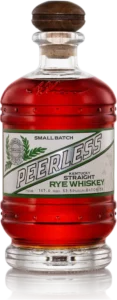
High rye whiskey has long been celebrated for its bold spice and complex character. Consequently, it stands apart from sweeter corn-heavy whiskeys, offering a distinct tasting experience. So, what exactly defines a “high rye” whiskey? To answer this, this guide explores its defining characteristics, historical roots, production process, and why it has become one of the fastest-growing whiskey styles in the U.S.
By U.S. law, rye whiskey must contain at least 51% rye grain in its mash bill. However, “high rye” whiskey is an informal term typically applied to those containing 70% or more rye, resulting in a more pronounced spice-forward profile. Some variations even reach 90-100% rye, creating a whiskey that is intensely robust, earthy, and spicy.
Unlike bourbon, which must be at least 51% corn and tends to be sweeter, high rye whiskey accentuates the natural dryness and spiciness of rye grain. Some distilleries experiment with additional malted barley or a touch of corn to round out the flavors, but the star remains the rye grain itself.
A Historical Perspective
Rye whiskey has deep roots in North American history. In the 18th century, European settlers—especially in Pennsylvania and Maryland—embraced rye as a staple grain due to its ability to thrive in the cool, rocky soil. This led to the birth of Monongahela Rye (Pennsylvania-style), which traditionally featured 80-100% rye for a bold, peppery profile, and Maryland-style rye, which included some corn for added sweetness.
By the 19th century, Americans had embraced rye whiskey as their preferred spirit. However, Prohibition (1920-1933) nearly wiped out its production. While bourbon recovered quickly post-Prohibition, rye whiskey remained a niche category until the 21st-century craft whiskey boom brought it back into the spotlight. Today, major distillers and craft producers alike are once again embracing high rye whiskey, leading to its rapid resurgence in popularity. High West played a major role in making rye whiskey popular again in the 21st century, and it was a meeting with founder David Perkins in 2009 that first turned me onto rye.
The Production Process
The production of high rye whiskey follows the same key steps as other American whiskeys.
1. Mashing
Milling and cooking the grains at precise temperatures allow for optimal starch conversion. Rye’s high protein content can make the mash thick and sticky, requiring careful handling.Distillers often add malted barley to assist with enzymatic breakdown.
2. Fermentation
After cooling, distillers transfer the mash to fermentation tanks and add yeast to convert sugars into alcohol.
Rye fermentation can produce fruity esters, alongside rye’s signature spicy and herbal notes.
3. Distillation
Most distillers use column stills for efficiency, followed by a second run in a pot still or doubler for refinement. In contrast, a few distilleries, such as NOCO Distillery, take a different approach by triple pot distilling their rye. This method results in a uniquely refined spirit with enhanced depth and smoothness.
4. Aging
To qualify as American rye whiskey, the spirit must age in new, charred oak barrels. This maturation process develops rich vanilla, caramel, and oak notes, balancing rye’s natural spice. While some high rye whiskeys mature for just two years, distillers often age premium expressions for 4-10 years or more. This extended aging process allows the whiskey to develop greater depth and complexity, enhancing its bold spice and oak-infused character.
5. Bottling
Once the aging process is complete, distillers dilute high rye whiskey to 40-50% ABV before bottling to achieve a balanced flavor. Meanwhile, for those seeking a more intense and unfiltered experience, barrel-proof expressions and unique cask finishes, such as sherry or port cask maturation, introduce enhanced layers of complexity and depth, making the final whiskey even more distinctive.
High Rye Whiskey Brands
Here are some High Rye Whiskeys you might enjoy:
- Alberta Premium Cask Strength (100% rye) – A bold and intense Canadian rye.
- Bulleit Rye (95% rye) – A spicy, dry, and peppery favorite.
- Catoctin Creek Roundstone Rye (100% rye) – A Virginia-based organic rye whiskey known for its smooth, balanced spice.
- High West Double Rye (blend of 95% and 80% rye) – A complex, spicy whiskey with herbal and honeyed notes.
- New Riff 100% Malted Rye (100% malted rye) – A unique twist on traditional high rye whiskey.
- NOCO Distillery Rye (95% rye & 100% malted rye) – Is triple distilled, elegant, complex, ultra smooth.
- Redemption 10-Year High Rye (95% rye) – A well-aged, full-bodied rye with depth.
- WhistlePig 10-Year (100% rye) – A rich and complex aged rye.
- Wilderness Trail Rye (95% rye) – A sweet and spicy Kentucky rye with a bold finish.
- Peerless Rye Whiskey (95% rye) – A non-chill-filtered, small-batch rye with a creamy, rich texture.
Final Thoughts
High rye whiskey stands apart for its bold spice, deep heritage, and versatile appeal. Whether enjoyed neat, in classic cocktails like the Manhattan or Old Fashioned, or as a collector’s dram, it offers whiskey lovers a taste of both tradition and innovation. As more distillers embrace high rye mash bills, the future of this whiskey style looks as vibrant as its fiery, pepper-laced flavor.
Cheers!
